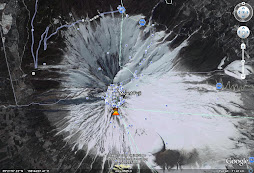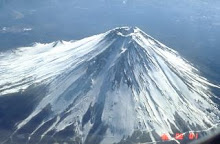
Friday, March 27, 2009
Type of Volcano~
Mt. Fuji is a stratovolcano. A stratovolcano is a large cone-shaped volcano consisting of alternating layers of lava. It is actually made of three different volcanos. They include Komitake, Ko Fuji and Shin Fuji. The most recent of the volcanoes is Shin Fuji. Shin Fuji has been active for roughly 10,000 years. Mt. Fuji is made up of many layers, of strata, ash and lava overlying each other. Fuji is a continental mountain.
Geologic Location~
Mt. Fuji is located on one of Japans largest islands, Honshu. Mt. Fuji is located due west of Tokyo. Mt. Fuji was formed by a subduction zone where the Philippine Sea Plate is sinking beneath Japan. However, a tear in the Philippine Sea Plate was found directly under Mt. Fuji, meaning that its formation is not solely because of the subduction zone.


Eruption History~
Carbon-14 Dating has been able to determine that Mt. Fuji has had approximately 63 eruptions in the past 9000 years. The most recent 22 eruptions have been recorded by people and most of these recorded eruptions were moderate to mderate-large in size. The last known eruption of Mt. Fuji was in the year 1708 from a vent on the southeast side of the cone. However, eruptions of Mt. Fuji have been recorded dating back to the 8th century. Five historic eruptions of Mt. Fuji have created damage, but Mt. Fuji has only had two large eruptions that we know of. The most recent and famous eruption, in the year 1708, was from a vent on the southeast side of the cone.
Volcano Shape~
Mt. Fuji is approximately 3,776 meters tall, making it Japan's tallest volcano. Mt. Fuji is a typical compositive volcano. There is a crater on the top of Mt. Fuji formed by it's latest eruption. This eruption also sparked the opening of three new vents, named the 1st, 2nd, and 3rd Hōei vents.
Neighboring Volcanoes~
Mount Fuji is composed of not one, but three different volcanoes. Mt. Fuji was created by a series of volcanic activity cauesd by Ko-Mitake (small mitake), Ko-Fuji (old Fuji) and Shin-Fuji (new Fuji) volcanoes. The Ko-Fuji volcano formed the base of the current Mt. fuji and has been dormant since 100 thousand years ago. The Ko-Fuji volcano was active betwee 100 thousand and 10 thousand years ago. Mount Fuji is a relatively young volcano and aquired its present shape about 5000 years ago. Shin-Fuji is responsible for Mt. Fuji's shape to this day. Shin-Fuji started to erupt about 10 thousand years ago and repeatedly erupted over 100 times during a span of about 10 thousand years. Although Mt. Fuji has been sleeping since its last eruption on November 24, 1707, geologists still regard it as an active volcano.
Eruption Style~
Mt. Fuj is a relatively safe volcano to climb, if you were to climb it during its climbing season (July-August). Mt. Fuji is a dominately basaltic volcano, emitting mostly basaltic lava. Pyroclastic flows plague the volcano, varying from large to small. Mt. Fuji is an explosive volcano, however it is not expected to erupt any time soon.
Cone name Time period Rock Type
Sen-komitake Several hundred thousand years ago (before Komitake) Andesite
Komitake Several hundred thousand years ago Basalt
Old Fuji ~100,000 years ago Basalt
New Fuji ~10,000 years ago Basalt
Cone name Time period Rock Type
Sen-komitake Several hundred thousand years ago (before Komitake) Andesite
Komitake Several hundred thousand years ago Basalt
Old Fuji ~100,000 years ago Basalt
New Fuji ~10,000 years ago Basalt
Subscribe to:
Comments (Atom)


